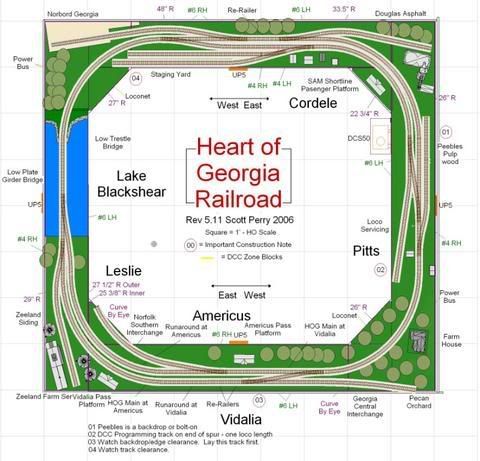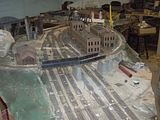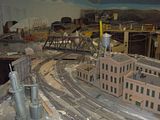Im designing a first layout in an area of my basement that is 9’x13’.It is my first layout so my main goal is to keep it as simple as possible. The layout will be freelanced with a continuous main line. I would like to have a decent size yard, 2 towns with switching in the towns and along the main line. I have been using cadrail to come up with some ideas but I always get to a point where I get indecisive. I ask my wife for her opinion, sometimes it helps but I could use the opinions of others who have built layouts before.
Welcome to the forum.
Some simple questions to start with:
What scale (H0 or N or some other scale) ?
What type of railroad (e.g. Midwestern granger, Appalachian coal hauler, Colorado mining road, Maine two footer etc)
What era ?
Typical train length (number of cars, type of cars) ?
Can you draw us a sketch showing your entire room - with doors and windows, where you have walls etc ?
What have you drawn yourself already ? What are you not satisfied with ?
Smile,
Stein
If you want to consider not constructing your own benchwork, permit me to point you in the direction of “Benchridge Benchworks” for a suggestion.
Im modeling in HO scale in modern day era. Not sure what type of railroad, but what I am thinking is 2 towns with passenger stations along with some industrial switching atleast one yard. Longest yard track should be long enough to hold 6-8 cars of mixed freight. I am building the layout in a 9’x13’ area in my basement. The layout would back up to 2 walls, no other obstructions. What Im having problems with designing is the yard. I will post some plans as soon as I figure it out.
Ummm - if you want to run modern era freight and passenger traffic, I would very seriously consider going to N scale.
A 40-foot car (1950s typical freight car) is 5.5" in H0 scale, 3" in N scale. An 89-foot freight or passenger car is a foot long in H0 scale, about 7" long in N scale.
(How calculation is done : prototype car is e.g. 60 foot long. That is 60 x 12 = 720 inches long. In H0 scale: 720/87.1 = 8.3", in N scale: 720/160 = 4.5").
Going N scale or going older era makes quite a difference in train lengths. Your yard tracks would have to be this long to fit 8 cars in respectively H0 scale and N scale:
8 x 40-foot cars: 3.6 feet in H0 scale, 2 feet in N scale
8 x 60-foot cars: 5.5 feet in H0 scale, 3 feet in N scale
8 x 89-foot cars: 8 feet in H0 sca
Im designing a layout … that is 9’x13’.
main goal is to keep it as simple as possible.
freelanced
a continuous main line.
decent size yard
2 towns
switching in the towns and along the main line
Later it was added - modern era, want passenger station.
I agree with the prior poster. That is a lot to ask of HO scale in 9’x13’ with modern equipment. Modern equipment is huge. A passenger siding will take up a strip on that whole 13’ side.
I assume the “yard” means a classification yard. It was not mentioned how many “off layout” towns there would be, or what sort of hidden/stagging tracks there are. These will dictate the make up of the yard. A yard simply for two switching town only needs 3/4 tracks. One arrival track, one make up track (departure) and two classification tracks - one for each town. On the other hand if there are multiple towns off the layout somewhere. One could add a track for each of those. So take the most simple scenario - add two tracks to the yard for all points east and all points west. That brings it up to six tracks. Once again for modern equipment, assuming a nice 24" minimum (preferably 30") curve in and out, room for a ladder (two if double ended), and that will probably consume at least a two foot wide strip down most of the 13’ side of the layout. It could be worked in conjunction with the passenger tracks.
And thinking about this. 9’ is a tough size. Not wide enough for an island. If one doesn’t want a duck under then it almost dictates two blobs, which dictate the yard on the opposite side. Hmmm. Are you adverse to bridging the entry? Exposure on two sides helps as it can be deeper along those sides.
Hmmm - did a quick sketch to explore options. For shorter cars (or N scale) it would possibly have been feasible to have two yards (which double as on-layout staging) on a central peninsula, combined with an around the wall layout, at least if 24" aisles are okay:

But for longer H0 scale equipment, like modern passenger and long freight cars, 22" radius going into the yard is probably pushing your luck.
Smile,
Stein
Tall order for HO in the space given, but not impossible depending on your standards. Consider a smaller interchange yard where you may have a dedicated switcher that could do local work to. The passing sidings would have to be so long that you may as well double track the entire layout or restrict your layout with two towns, one served by the yard. You could have a continuous run through the interchange and one town then have a branch line for more interest. You may be surprised how a small yard and one town can fill a space.
There are some great sources for track plans so invest in some books or downloads. Try a book or two on operations to maximize your fun.
The above has many plans from people all over.
Lots to consider.
Everyone has different ideas on how things should be.
Try different things, design things on paper. Read MR magazine to have a look at what other people are doing in the space you have for yourself. This is my approach to layout building.
Study the track designs, ask a bunch of questions as well.
Since this is, I’m assuming, your first layout, keep it simple at first but allow yourself to expand at a later date. Build a mainline ( a simple loop) so that you can see how much space you have for yards & spurs & to see how much space “your” average train is going to take up. By building a simple loop, you can also have trains running while scoping out your yards, spurs, scenery & towns.
Gordon
hi,
you’ve got a lot of advices, some great, some tmho not so great. I will present you an other railroad, the HOG (Heart of Georgia).

The main reason is the radius. Since 50 years a 2.5 ratio between the longest car and the radius is called tight. With modern 90 feet long cars your mimimum branchline radius in HO will be 30 inches and with it goes the use of #6 and #8 switches. The math: 90 : 87 x 2.5 x 12 is about 30.
Your space is a bit longer not wider, but the radii used are a under 30, trainlength is 5 feet. So you could built a pike like that in modern times in your space. Two stations, a small yard, an interchange and continious running, but no staging yard and no online switching.
Classification usually means building different trains for different destinations. Blocking is the word used for getting the cars in a train in the right order. So the first cut of cars is for the first station on the line, the second cut for the second station, etc. You don´t need a yardtrack for each station along the line. Blocking was often done apart from the main yards, and just two tracks will do the job, more can be handy of course.
Study`íng trackplans is nice to do, there are way to many. The two plans presented to you will give you an idea what can be done (or can´t be done) in HO in your space given your druthers (wishes). Both plans are single track branchline designs. Do they come close to what you were thinking?
Have fun, keep smiling
Paul
You may also think about a different time period. As sais older times used shorter cars. More cars in a given space. There are also shorter length passanger cars to consider. 50 foot Overland’s (although not as prototypical), 67 foot Hariman cars (which are now being advertised in N scale at trainworld IIRC), and 72 foot cars. I am also modeling a free-lance in N, however I will start with a small shelf (possible a two towner) and a small yard shelf to gain skills and experience. Stein has a good track plan, as usual. I’m using the net on my wifes cell so can’t see the tiny screen as well, but the yard looks to be split into two yards seperated b On a side note, what is a back drop. Easy to operate as two different locations. a granger line? I keep hearing this term lately.
hi
Milw asked some questions and stated Stein’s trackplan is good as usual. I second that, but Stein had a message; question is: did the message came home?
A backdrop is the end of a scene: a background. When put between two scenes like the two yards on Stein’s design, it is called a double sided backdrop.
A granger road is a rural line through the great plains; I don’t know where the word is coming from. Important in Stein’s story are the consequences; straight as an arrow, large radii and scattered buildings. So tight radii are out.
About carlength you are right, Stein talked about it too. Max. carlength in the 50’s was 50 feet, in the 70’s 60 feet, in the late 80’s 80 feet and today even 90 feet. I talked about a 2.5 ratio before as considered tight; on a granger road a 1:4 ratio would look more appropriate.
In the end you always have to set your own standards. It is your layout and you should have all the fun.
It sounds expensive, but do a little experiment; try to run three 90 feet coaches over a #4 switch. Pushing and pulling, with slow speeds and at full speed. May be you know some one who can set it up for you? Same with easements. Trying it out before starting a major built can be a way to go.
Paul
If you want to build a layout of that size as a starter project you are headed for problems. not because of your skill but because of you previous lack of failure so that you have enough experience to avoid the problem issues. I would strongly suggest a four by eight railroad to generate the following skills:
-
laying straight track
-
laying curves that work
-
laying turnouts
-
wiring skills
-
scenery skills
If you still want to build a bigger layout right out of the box then you ought to do each one of these things on a test section so you have some experience before beginning. Even those of us building layouts for forty years in my case still run into things we never saw before.
If you want to build a layout of that size as a starter project you are headed for problems. not because of your skill but because of you previous lack of failure so that you have enough experience to avoid the problem issues. I would strongly suggest a four by eight railroad to generate the following skills:
laying straight track
laying curves that work
laying turnouts
wiring skills
scenery skills
If you still want to build a bigger layout right out of the box then you ought to do each one of these things on a test section so you have some experience before beginning. Even those of us building layouts for forty years in my case still run into things we never saw before.
I agree that a test layout is probably the way to go.
But why not try Scott Perry’s HOG (Heart of Georgia) plan instead of a 4x8. It’s the one Paulus Jas mentioned further up in this thread.
You get to learn all the skills mentioned above, it is fairly simple to build (comes with complete cutting instructions etc), and yet it gives you curves that are good to go with modern equipment in H0 scale (which is what the OP wanted), as well as a number of visually separate scenes where one can try out different scenery techniques.
Website: http://home.comcast.net/~scottgperry/site/?/page/Heart_of_Georgia_Beginner’s_Train_Layout
Smile,
Stein
I could see you doing the large layout it will just take some time and from what it sounds like I would suggest that you go with n scale since you want to go with modern stuff because its larger and requires a larger radius in Ho scale and if you go with N scale you can have a smaller Radius and still run the modern stuff and have more room to put track towns ect, than if you went with ho you would have less room to work with now since you are building a larger layout the important thing is to take it one step at a time now if you think the layout would be too much of a daunting task for a first layout then I would suggest the basic 4’x8’ just to get your feet wet in the hobby and then after you finish the 4x8 you can then move on to your larger layout.
hi,
for some it seems a daunting task, but the Hog is built, except the triangels in the corners, out of 4 boards. All four are 8 by 1 feet; together just a 8x4 sheet of plywood.
The result is far beyond the possibilities of the usual 8x4. Much larger radii are possible and curving the stations results in a decent trainlength. Using the curve as a scenic devider you even have a layout with four scenes. The resulting design is far more spacious and much more suited to a rural area then a 8x4.
The Hog was meant as a starters layout, tmho a very good one if you want a branchline out in the country.
Paul
Broseberry,
In your situation, something like the HOG layout wouldn’t be too complicated. If it were a midwest theme, scenery would be simple, as well as benchwork since there would be no need for grades. You can selectively tighten the radius of the curve in places too, if it made sense. The states of Indiana, Ohio, Illinois, Wisconsin, and Iowa, to name a few, have areas near rivers that can be quite hilly, maybe requiring a railroad to have a tighter than desired curve to line up the track for where it chose to cross the narrow part of the river. (cheaper to build a short bridge to cross the narrow portion of the river than a long bridge to cross the wider portion, duh) . If your layout was 52 inches, your 2x6 or 8 table top that had the river scene could be built at 48 inches, using simple risers to support the track as it decends slightly to the bridge. Not difficult to build and the scene would have a slight realistic looking grade.
For the HOG in your case, I would eliminate the two staging tracks and rework that town a bit to have a small yard on the outside of the loop, terminating into the wall in a corner. You could install a mirror and practice that scenic skill. Any one of the tracks in the corners of the layout could be used for staging, if you wanted it. I would eliminate the town of Pitts and replace it with scenery or a single larger industry, but that’s a matter of personal taste.
Good luck and keep us posted.
I do believe I came to the right place for information. All who have responded have given me some very helpful tips and great insights.As this is my first layout I had been considering a 9’x13’ shelf layout with a duck under, but after reading all the comments and thinking about each, I will reconsider my original ideas and even consider switching to N scale. Either way I will continue to ask questions, read and respond to all comments, ideas and insights for further modeling tips. I thank all who have responded.
Welcome to the Forums, Yes indeed, you have come to the proper place for critiques on proposed layouts. I would go for the N scale, two track main, with the use of double-slip switch crossovers. Lengthy run arounds would add to the multi-train possibilities. I use a spur for switcher storage, and double-slip switch escape routes for the switcher. All of these things would be much simpler with N scale. Bob Hahn  This is a view of my 7-track stub ended yard, with access to any track from any track and an overhead loop main, (which might be possible on your yard, with N scale. Another view of the same 7-track yard, showing two lengthy “drill tracks” which allow for forming a “consist” without having to go onto the mainline.
This is a view of my 7-track stub ended yard, with access to any track from any track and an overhead loop main, (which might be possible on your yard, with N scale. Another view of the same 7-track yard, showing two lengthy “drill tracks” which allow for forming a “consist” without having to go onto the mainline. 
Well I was finally able to get a picture to post. the picture is of the area that intend to build in.